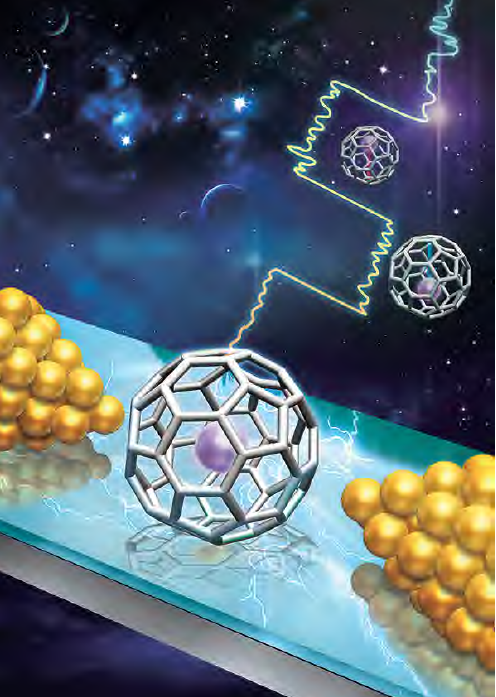(Researchers Create a Single-Molecule Switch ? a Step Toward Ever-Smaller Electronics)
2020/10/12 アメリカ合衆国・イェール大学

・ イェール大学、中国・南京大学、中国人民大学、厦門大学、英国・レンセラー大学が、分子コンピューター開発の鍵となるデバイスである、単一分子のエレクトレット(電石)を世界で初めて実証。
・ より高度なコンピューターやデバイスの開発では、微細なエレクトロニクスが重要な役割を担う。そのため、極微細な不揮発性記憶装置のプラットフォームとして機能する切り替えデバイスである分子で、従来のシリコンチップを代替する技術の研究が推進されている。
・ その多くがスピーカーの発音に利用されるような圧電性材料で作られるエレクトレットでは、全ての双極子(一対の電荷)が同方向に自己整列し、電場をかけることで整列方向を変換できる。本質的にはメモリ貯蔵デバイスであり、その微細化が課題となっている。
・ カーボンのバッキーボール(32 面体の分子でバックミンスターフラーレンとしても知られる)にガドリニウム(Gd)原子を挿入した Gd@C82 をトランジスタのような構造に構築し、電子輸送の観察によりそのエネルギー状態を解明。電場の利用により、ある安定した状態から別の状態へとエネルギー状態を切り替えられることがわかった。
・ 本研究のブレイクスルーは、同分子による安定した 2 つの分極状態を有するような挙動の発見。電場をかけている間の電子輸送特性の測定や状態の切り替えによる様々な試験の結果、読み書きできるメモリとしての機能を確認した。
・ 現時点のデバイス構造にはアプリケーションでの実用性はないが、分子において自律的な分極と切り替え可能な 2 つの状態が創出できるという発見は、単一分子レベルまでメモリの縮小が可能であることを示唆。この理解を踏まえ、今後も研究を進める。
URL: https://seas.yale.edu/news-events/news/researchers-create-single-molecule-switch-steptoward-ever-smaller-electronics
<NEDO海外技術情報より>
(関連情報)
Nature Nanotechnology 掲載論文(アブストラクトのみ:全文は有料)
A Gd@C82 single-molecule electret
URL: https://www.nature.com/articles/s41565-020-00778-z
Abstract
Electrets are dielectric materials that have a quasi-permanent dipole polarization. A single-molecule electret is a long-sought-after nanoscale component because it can lead to miniaturized non-volatile memory storage devices. The signature of a single-molecule electret is the switching between two electric dipole states by an external electric field. The existence of these electrets has remained controversial because of the poor electric dipole stability in single molecules. Here we report the observation of a gate-controlled switching between two electronic states in Gd@C82. The encapsulated Gd atom forms a charged centre that sets up two single-electron transport channels. A gate voltage of ±11 V (corresponding to a coercive field of ~50 mV Å–1) switches the system between the two transport channels with a ferroelectricity-like hysteresis loop. Using density functional theory, we assign the two states to two different permanent electrical dipole orientations generated from the Gd atom being trapped at two different sites inside the C82 cage. The two dipole states are separated by a transition energy barrier of 11 meV. The conductance switching is then attributed to the electric-field-driven reorientation of the individual dipole, as the coercive field provides the necessary energy to overcome the transition barrier.



